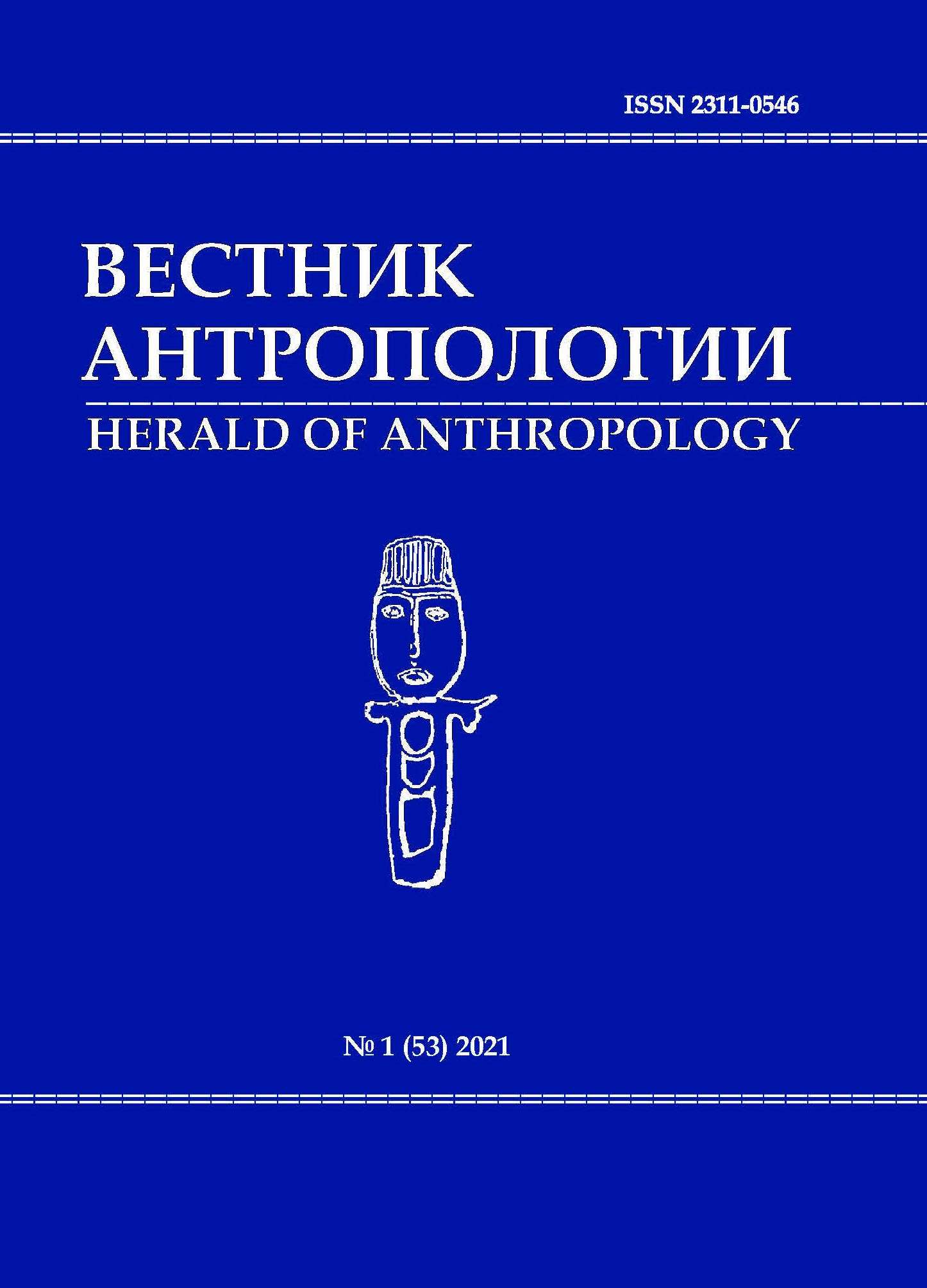Population of the Jetyasar culture in the Eurasian space
DOI: 10.33876/2311-0546/2021-53-1/202-218
Keywords:
Antiquity, middle ages; archaeological cultures, Jetyasar culture; burial complexes; paleoanthropology, craniology, craniometric traits, morphological complexesAbstract
Anthropological materials from closed burial complexes of the Jetyasar culture were studied. They date back to the time span from late antiquity to the early Middle ages (III-VIII centuries). The total craniological sample includes 284 skulls (149 male and 135 female). It was revealed that all the paleopopulations of the Jetyasar culture of the period under consideration have a fairly close morphological composition. These populations had morphological and genetic ties, on the one hand, with the local sedentary and pastoral population of Central Asia and South Kazakhstan, and on the other, with the Savromats and Sarmatians of Ustyurt and Western Kazakhstan, the late Sarmatians of the Lower Volga and Southern Urals. The approach proposed by archaeologists to consider separately closed burial complexes as the most informative for their dating is acceptable, according to our results.
For Citation: Khodzhayov T.K., G.K. Khodzhayova. 2021. Jetyasar population in Eurasia. Herald of Anthropology (Vestnik Antropologii) 1 (53): 202–218.
References
- Botalov, S.G. 2009. Gunny i tiurki (istoriko-arkheologicheskaia rekonstruktsiia). [Huns and Turks (historical and archaeological reconstruction)]. Cheliabinsk: OOO “TsIKR “Rifei”:
- Khodzhaiov, T.K., and T.P. Kiiatkina. 2002. Arkheologo-antropologicheskaia kharakteristika naseleniia dzhetyasarskoi kul’tury Vostochnogo Priaral’ia. [Archaeological and anthropological characteristics of the population of the Djetyasar culture of the Eastern Aral Sea region]. Na putiakh biologicheskoi istorii chelovechestva. Sbornik statei. Vol. II, 2: 56–85. Moscow: IEA RAN.
- Kiiatkina, T.P. 1995. Kraniologicheskie issledovaniia iz mogil’nikov Altynasar 4. [Craniological research from the Altinasar 4 burial grounds]. Nizov’e Syrdar’i v drevnosti. Vol. V. Dzhetyasarskaia kul’tura. Pt. 5, 5 (5): 240–281. Moscow: IEA RAN.
- Kiiatkina, T.P. 1995. Kraniologicheskii material iz Tompakasarskogo mogil’nika [Craniological material from the Tompakasar burial ground]. Nizov’e Syrdar’i v drevnosti. Vol. V. Dzhetyasarskaia kul’tura. Pt. 5, 5 (5): 282–289. Moscow: IEA RAN,
- Kiiatkina,T.P. 1993. Kraniologicheskii material iz sklepov mogil’nikov Altynasar 4, Tompakasar i Kosasar [Craniological material from the crypts of Altynasar 4, Tompakasar and Kosasar burial grounds]. Nizov’e Syrdar’i v drevnosti. Vol. II. Dzhetyasarskaia kul’tura. Pt. 1. Sklepy, 2 (1): 224–242. Moscow: IEA RAN.
- Levina, L.M. 1992. Pamiatniki dzhetyasarskoi kul’tury serediny I tys. do n.e. – I tys. n.e. [Monuments of the Dzhetasar culture of the middle of the 1st millennium BC - 1st millennium AD]. Arkheologiia SSSR. Stepnaia polosa Aziatskoi chasti SSSR v skifo-sarmatskoe vremia, 61–72. Moscow: Nauka.
- Levina, L.M. 1993. Dzhetyasarskie sklepy. [Dzhetyasar Crypts]. Nizov’e Syrdar’i v drevnosti. Vol. II. Dzhetyasarskaia kul’tura. Pt. 1, 2 (1): 33–198. Moscow: IEA RAN.
- Levina, L.M. 1994. Mogil’niki Altynasar 4. [Altynasar Cemetery 4]. Nizov’e Syrdar’i v drevnosti. Vol. IV. Dzhetyasarskaia kul’tura. Pt. 3-4, 4 (3–4). Moscow: IEA RAN.
- Levina, L.M. 1996. Etnokul’turnaia istoriia Vostochnogo Priaral’ia: I tys. do n.e. – I tys.n.e. [Ethnocultural history of the Eastern Priaralye: 1st millennium BC - 1st millennium AD]. Moscow: IEA RAN.
- Malashev, V.Yu., and L.T. Yablonskii. 2008. Stepnoe naselenie Iuzhnogo Priural’ia v pozdnesarmatskoe vremia (po materialam mogil’nika Pokrovka 10). [The steppe population of the Southern Urals in the Late Sarmatian period (based on materials from the Pokrovka 10 burial ground)]. Moscow: Izdatel’skaia firma “Vostochnaia literature” RAN.
- Malashev, V.Yu., and M.G. Moshkova. 2010. Proiskhozhdenie pozdnesarmatskoi kul’tury (k postanovke problemy). [The origin of the late Sarmatian culture (to the problem statement)]. Stanovlenie i razvitie pozdnesarmatskoi kul’tury (po arkheologicheskim i estestvennonauchnym dannym). Materialy seminara Tsentra izucheniia istorii i kul’tury sarmatov. Vol. III. Volgograd: Volgogradskii gosudarstvennyi universitet 3: 37–56.
- Nerazik, E.E. 1966. Sel’skie poseleniia afrigidskogo Khorezma. [Rural settlements of Afrigid Khorezm]. Moscow: Nauka.
- Rykushina, G.V. 1993. Materialy po odontologii dzhetyasarskoi kul’tury. Gruntovye pogrebeniia mogil’nikov Kosasar 2, Kosasar 3, Tompakasar, Bedaikasar. [Materials on the odontology of the Dzhetyasar culture. Ground burials of the burial grounds of Kosasar 2, Kosasar 3, Tompakasar, Bedaikasar]. Nizov’e Syrdar’i v drevnosti. Vol. III. Dzhetyasarskaia kul’tura. Pt. 2. Mogil’niki Tompakasar i Kosasar, 3 (2): 195–205. Moscow: IEA RAN.
- Rykushina, G.V. 1993. Odontologicheskaia kharakteristika cherepov iz sklepov dzhetyasarskoi kul’tury (Altynasar 4, Tompakasar, Kosasar 3). [Odontological characteristics of skulls from crypts of the Dzhtyasar culture (Altynasar 4, Tompakasar, Kosasar 3)]. Nizov’e Syrdar’i v drevnosti. Vol. II. Dzhetyasarskaia kul’tura. Pt. 1. Sklepy: 243–252. Moscow: IEA RAN.
- Vainberg, B.I. 1999. Etnografiia Turana v drevnosti. VII v.do n.e. – VIII vv. n.e. [Ethnography of Turan in antiquity. VII century BC – VIII centuries. AD]. Moscow: Vostochnaia literature.





















